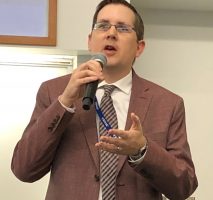The CARES Act, which was enacted in late March as a result of the COVID-19 outbreak, includes a variety of programs aimed at pandemic response and economic recovery. The Small Business Administration’s (SBA) Paycheck Protection Program (PPP) is a key example of the latter category. As Congress considers additional initiatives and amendments to the PPP in another major stimulus bill, they could turn to the power of GIS to better understand some of the impacts the PPP has had across the nation.
On July 6, the SBA released detailed information about PPP loans in two major categories: loans of $150,000+ and those under $150,000. The data provided for the larger loans contains information about the size of the loan (grouped into five ranges); name of the business and recipient address; the entity’s NAICS code, which is used by statistical agencies to group businesses into specific industries; the business type (i.e., corporation; LLC; S corp; non-profit organization…); the lending institution; and the number of jobs the business expects to be able to retain as a result of the loan.
This last piece of information is important, because a crucial component of the PPP is that loans under the program may be forgiven (in full or in part) if a business maintains its employee count and keeps wages stable. The SBA also released answers to three optional questions that appeared on loan applications: the gender, race and ethnicity, and veteran status of the business’s owners. These questions went unanswered on the vast majority of loan applications, so this interesting demographic data is unfortunately of little value.
Through the CARES Act and subsequent reauthorization actions, our government has invested $669 billion so far in the PPP. So what can GIS help us understand about some of the key outcomes of this funding? By visualizing some of the categorization data for the loans of $150,000+ through ArcGIS Insights, a few important pieces of information become clear.
PPP loans have, on average, helped non-profit organizations retain more employees than businesses (see the bar chart below). Nonprofit PPP recipients are retaining a mean of 79.3 jobs vs 47.6 for corporations, 50.4 for LLCs, and 49.1 for S Corps. These four types of entities account for the vast majority of total jobs saved through the PPP. The disparity in favor of nonprofits is even more striking considering that data from the U.S. Bureau of Labor Statistics shows that nonprofit employees earn an average of about $10,000 more annually than their counterparts in the private sector.
When looking at data tied to specific industries, loans to educational services organizations and accommodation and food services businesses provided the biggest bang for the buck. Ed services groups retained an average of 67.8 jobs per loan and accommodation and food services businesses retained a mean of 67.2 jobs per loan (see the treemap below for a visualization of this data). These numbers compare quite favorably vs the overall average of 54 jobs retained per PPP loan of $150,000 or greater.
Another crucial outcome of the PPP can be understood through the analysis capabilities of the ArcGIS platform along with data available through Esri’s Living Atlas and other sources. A map showing hot- and cold-spots of counties that on average received higher or lower numbers of PPP loans per total number of businesses can be generated, and when compared to a separate map showing hot- and cold-spots for median income levels across the United States, clear patterns emerge.
Strong hotspot correlations exist in the Pacific Northwest; California’s coastal cities and areas; northern Utah; the upper Midwest’s urban areas from the Twin Cities to Detroit; and the Northeast Corridor from Washington, D.C. to Boston. Meanwhile, cold spots are found on both maps in portions of New Mexico and southern Colorado; Arkansas and surrounding areas of other states; and significant portions of Kentucky, Tennessee, West Virginia, and western North Carolina. One notable geography where the maps diverge is in portions of North Dakota, where incomes have risen rapidly as the result of fracking but banking networks have not kept pace.
See the swipe map below to examine these patterns. The map on the left side shows hot- and cold-spots for PPP loans by county and the map on the right shows hot- and cold-spots for median income by county. Use the slider to move between the two maps. The full size app can be accessed here.
The strong correlation between income levels and access to capital, even through a government relief program such as the PPP, is likely a symptom of the growing wealth divide in the United States. According to Bloomberg, the nation’s lower-income areas lost a net of almost 2,000 bank branches between 2014 and 2018. About a quarter of Americans are unbanked or underbanked, meaning they either don’t have access to banking services or have limited access. Small businesses in lower income areas were clearly harmed by this trend through lack of access to crucial PPP loans.
As Congress works to develop and pass another large stimulus bill, they are considering a number of proposals that would amend the PPP. The data derived through location intelligence could be a critical asset to legislators as they strive to boost the economy by sustaining small businesses and organizations in all American communities.

Article Discussion: